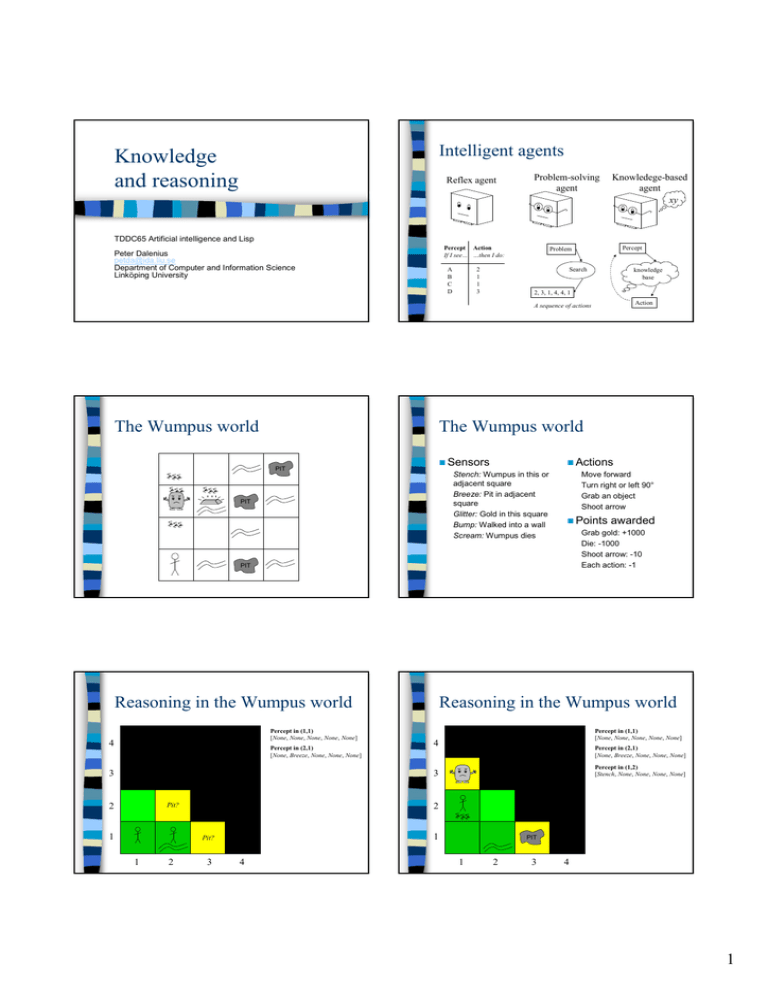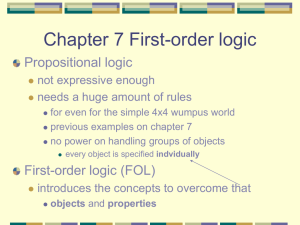Knowledge and reasoning Intelligent agents
advertisement

Intelligent agents
Knowledge
and reasoning
Reflex agent
Problem-solving
agent
Knowledege-based
agent
xy
TDDC65 Artificial intelligence and Lisp
Percept Action
If I see… …then I do:
Peter Dalenius
petda@ida.liu.se
Department of Computer and Information Science
Linköping University
A
B
C
D
2
1
1
3
Percept
Problem
Search
knowledge
base
2, 3, 1, 4, 4, 1
Action
A sequence of actions
The Wumpus world
The Wumpus world
Sensors
PIT
Actions
Stench: Wumpus in this or
adjacent square
Breeze: Pit in adjacent
square
Glitter: Gold in this square
Bump: Walked into a wall
Scream: Wumpus dies
PIT
Move forward
Turn right or left 90°
Grab an object
Shoot arrow
Points
PIT
Reasoning in the Wumpus world
Percept in (1,1)
[None, None, None, None, None]
4
Percept in (2,1)
[None, Breeze, None, None, None]
3
Reasoning in the Wumpus world
Percept in (1,1)
[None, None, None, None, None]
4
Percept in (2,1)
[None, Breeze, None, None, None]
Percept in (1,2)
[Stench, None, None, None, None]
3
Pit?
2
1
1
2
Pit?
2
1
Pit?
3
4
awarded
Grab gold: +1000
Die: -1000
Shoot arrow: -10
Each action: -1
PIT
Pit?
1
2
3
4
1
Reasoning in the Wumpus world
Percept in (1,1)
[None, None, None, None, None]
4
Percept in (2,1)
[None, Breeze, None, None, None]
Percept in (1,2)
[Stench, None, None, None, None]
3
Percept in (2,2)
[None, None, None, None, None]
Pit?
2
1
Percept in (2,3)
[Stench, Breeze, Glitter, None, None]
Knowledge-based agents
What
do we need?
– A way of representing the agents’
(increasing) knowledge about the world.
– A way of drawing conclusions from what
we already know.
We
also need to implement this in a
computer language at some point!
PIT
Pit?
1
2
3
4
Logic
Logic represents knowledge
Logic rules
of deduction
Knowledge base:
R
R⇒S
Representation
deduce
or infer
entails
semantics
Formalize, deduce and reinterpret
Sentences
Representation
Sentences
semantics
a set ∆ of true facts about the
world and a statement A, is there a
good argument for believing that A is
true based on the facts in ∆?
Logic is about making distinctions
between good arguments and bad
arguments, and the different criteria that
may be used in making this distinction.
Given
World
Aspects of the
real world
follows
Aspects of the
real world
Components of a logic
Syntax
Conclusion:
S
– Rules that specify what a well formed
sentence (or formula) looks like
– Tells us how to build a knowledge base
Semantics
World
formalize
Description of the world:
• It is raining.
• After rain comes sunshine.
reinterpret
Conclusion:
• There will be sunshine.
– Rules that specify what a sentence (or
formula) really means in the world
– Tells us what the knowledge base means
2
Syntax of propositional logic
The meaning of symbols
What does a well formed sentence (or formula) look like?
Sentence
Atom
Symbol
ComplexSentence
→ Atom | ComplexSentence
→ True | False | Symbol
→P|Q|R|…
→ ¬Sentence
| (Sentence ∧ Sentence)
| (Sentence ∨ Sentence)
| (Sentence ⇒ Sentence)
| (Sentence ⇔ Sentence)
The symbols denote atomic statements that
says something about the world.
¬P
negation (means the opposite of P)
P ∧ Q conjunction (means both P and Q)
P ∨ Q disjunction (means P or Q, or possibly both)
P ⇒ Q implication (means ”if P then Q”)
P ⇔ Q biconditional (means “P if and only if Q”)
Interpretations in propositional logic
Semantics of propositional logic
An
What is the value of a sentence, given an interpretation m?
interpretation assigns a truth value
(true or false) to each propositional
symbol in the knowledge base.
Examples:
m1 = {P = false, Q = false, R = true}
m2 = {S1 = true, S2 = true}
Example
• The constans True and False have their obvious values.
• Any symbol has the value indicated by the interpretation.
• The value of complex sentences are computed according
to the following truth table:
P
Q
¬P
P∧Q
F
F
T
T
F
T
F
T
T
T
F
F
F
F
F
T
F
T
T
T
T
T
F
T
T
F
F
T
Example
Is ((¬P ∨ Q) ⇒ P) a well formed sentence?
What is the value of ((¬P ∨ Q) ⇒ P)?
((¬P ∨ Q) ⇒ P)
SENTENCE ⇒ SENTENCE
(¬P ∨ Q)
SENTENCE ∨ SENTENCE
¬P
Q
¬ SENTENCE
ATOM
P
P∨Q P⇒Q P⇔Q
P
ATOM
There are four possible interpretations,
corresponding to the
rows in the truth table.
P
Q
¬P ∨ Q
¬P ∨ Q ⇒ P
F
F
T
T
F
T
F
T
T
T
F
T
F
F
T
T
The value of the sentence (or formula) in each
of the four interpretations can be found in
the rightmost column of the truth table.
ATOM
3
Properties of sentences
A sentence is satisfiable if it is true in some
interpretation.
An interpretation where a sentence is true is called a
model for that sentence.
A sentence is valid if it is true in all possible models.
Such a sentence is called a tautology.
A contradiction is a sentence with no models.
Two sentences A and B are logically equivalent
(A ≡ B) if they have the same values in all possible
interpretations.
All of these properties can be verified with a truth
table.
Some standard equivalences
(P ∧ Q) ≡ (Q ∧ P)
(P ∨ Q) ≡ (Q ∨ P)
((P ∧ Q) ∧ R) ≡ (P ∧ (Q ∧ R))
((P ∨ Q) ∨ R) ≡ (P ∨ (Q ∨ R))
¬(¬P) ≡ P
(P ⇒ Q) ≡ (¬P ∨ Q)
¬(P ∧ Q) ≡ (¬Q ∨ ¬P)
¬(P ∨ Q) ≡ (¬Q ∧ ¬P)
commutativity
commutativity
associativity
associativity
double negation
implication elimination
de Morgans’s law
de Morgans’s law
Equivalence can be proved by rewriting the sentence using these rules.
Entailment
Example
If
If we know that P ∧ Q is true, a logical consequence
is that P must be true, so P ∧ Q╞ P. Is this a correct
way of reasoning?
a sentence B is a logical consequence
of a sentence A, we say that A entails
B (A╞ B).
The formal definition of entailment is
that all models of A should also be
models of B. (I.e. in all interpretations
where A is true, B is also true.)
Informally we can say that the truth of B
lies hidden in A.
P
Q
F
F
T
T
F
T
F
T
P∧Q
F
F
F
T
We can generalize this and let P and Q be arbitrary sentences,
not just symbols. We have found an inference rule
(a reasoning pattern) called and-elimination.
Some inference rules
Proof systems
It can be quite boring to prove entailment using truth tables,
so instead we try to use reasoning patterns called
inference rules.
A
Modus ponens
A A⇒B
B
And-elimination
A∧B A∧B
A
B
And-introduction
A B
A∧B
In all interpretations
where P ∧ Q is true
(only the last row)
P is also true, so we
have proven that P ∧ Q╞ P.
proof system PS is a set of inference
rules.
A proof is a sequence of sentences
where each sentence can be inferred
from a previous sentence using one of
the inference rules.
A ├PS B means that there exists a proof
starting with A (which might be a set of
sentences), ending with B, using the
proof system PS.
4
Example
So, what is a good argument?
Prove that {P ∧ Q, Q ⇒ R} ├PS P ∧ R where PS is a proof
system containing the inference rules from the previous slide.
(1) P ∧ Q
(2) Q ⇒ R
(3) Q
(4) R
(5) P
(6) P ∧ R
We can try to prove
base:
KB╞ S,Knowledge
which
involves
R truth tables
or reasoning
R ⇒ Swith
interpretations,
models,
etc.
Representation
(Semantic proof)
And-elimination on (1)
Logic rules
of deduction
deduce
or infer
Or we can try to find
a proof KB├ S, using
some well known
Conclusion:
Sproof system.
(Syntactic proof)
Modus ponens on (2) and (3)
World
And-elimination on (1)
And-introduction on (5) and (4)
Properties of proof systems
for any set of sentences ∆ and any
sentence A, ∆├PS A implies that ∆╞ A,
then the proof system PS is sound.
If
– You can only prove things that are logical
consequences.
for any set of sentences ∆ and any
sentence A, whenever ∆╞ A there exists
a proof of A from ∆ using PS, then PS is
complete.
If
formalize
reinterpret
Description of the world:
• It is raining.
• After rain comes sunshine.
Conclusion:
• There will be sunshine.
Resolution
Proof
system with only one rule
Sound and complete
Fairly easy to implement in a computer
Drawback is you have to rewrite all
formulas to fit the rule
– All logical consequences can be proven.
The resolution rule
Rewriting to CNF
p 1∨ p 2 ∨ … ∨ p n ∨ r
p1∨ p2 ∨ … ∨ pn ∨ q1∨ q2 ∨ … ∨ qn
pi and qi are literals, i.e. symbols or negated symbols.
This type of formulas are called clauses.
We have to rewrite all formulas to conjunctions of clauses.
This format is called CNF (conjunctive normal form).
Rewrite ⇔ and ⇒
(P ⇔ Q) ≡ (P ⇒ Q) ∧ (Q ⇒ P)
(P ⇒ Q) ≡ ¬P ∨ Q
q1∨ q2 ∨ … ∨ qn ∨ ¬r
Move ¬ inwards
¬ ¬P ≡ P
¬(P ∨ Q) ≡ (¬P ∧ ¬Q)
¬(P ∧ Q) ≡ (¬P ∨ ¬Q)
double negation
De Morgan
De Morgan
Distributivity laws
P ∧ (Q ∨ R) ≡ (P ∧ Q) ∨ (P ∧ R)
P ∨ (Q ∧ R) ≡ (P ∨ Q) ∧ (P ∨ R)
5
How to use resolution
Example 1
The
starting point is that we want to
prove ∆├ A using resolution.
This is the same as ∆ ∪ {¬A}├ ⊥
Convert all formulas to CNF and
separate the clauses.
Using the resolution rule, try to prove ⊥
(contradiction).
We
Example 1
Example 2
want to prove
(P ⇔ Q) ⇒ P ├ P ∨ Q
This is the same as proving
{(P ⇔ Q) ⇒ P, ¬(P ∨ Q)} ├ ⊥
We now convert formulas to CNF:
{P ∨ Q, ¬P, ¬Q} ├ ⊥
We
P∨Q
¬P
¬Q
Q
Example 2
(¬A ∧ B) ⇔ C
≡ ((¬A ∧ B) ⇒ C) ∧ (C ⇒ (¬A ∧ B))
≡ (¬(¬A ∧ B) ∨ C) ∧ (¬C ∨ (¬A ∧ B))
≡ ((¬¬A ∨ ¬B) ∨ C) ∧ (¬C ∨ (¬A ∧ B))
≡ ((A ∨ ¬B) ∨ C) ∧ (¬C ∨ ¬A) ∧ (¬C ∨ B)
want to prove
(¬A ∧ B) ⇔ C ├ ¬C
This is the same as proving
{(¬A ∧ B) ⇔ C, C} ├ ⊥
We now convert the formulas to CNF…
Example 2
A ∨ ¬B ∨ C
¬C ∨ ¬A
¬C ∨ B
C
¬B
¬C
The same formula in clause form:
{A ∨ ¬B ∨ C, ¬C ∨ ¬A, ¬C ∨ B}
6


